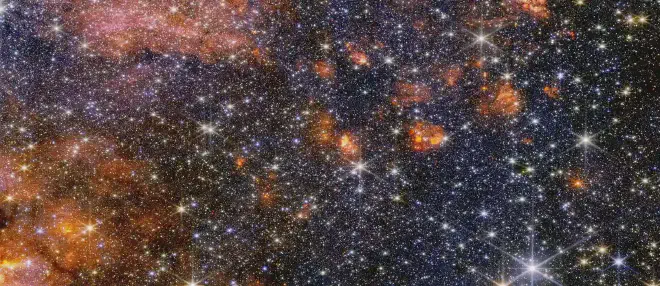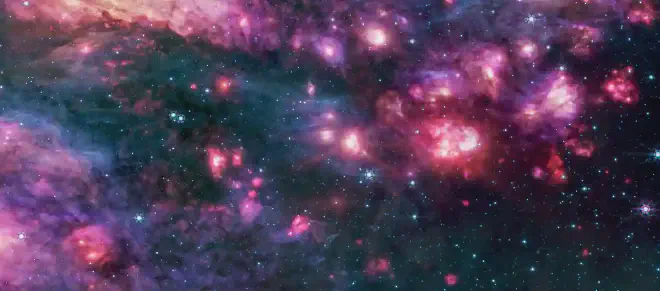

Sagittarius B2 is the Milky Way galaxy’s most massive and active star forming cloud, producing half of the stars created in the galactic centre region despite having only 10 percent of the area’s star-making material. Now, Webb has revealed stunning new views of the region, using both its near-infrared and mid-infrared instruments, to capture both its colourful stars and gaseous stellar nurseries in unprecedented detail, announced Webb’s European branch

“Webb’s powerful infrared instruments provide detail we’ve never been able to see before, which will help us to understand some of the still-elusive mysteries of massive star formation and why Sagittarius B2 is so much more active than the rest of the galactic center,” said astronomer Adam Ginsburg of the University of Florida, principal investigator of the program.
¿Where is Sagittarius B2? #
Sagittarius B2 is located only a few hundred light-years from the supermassive black hole at the heart of the galaxy called Sagittarius A*, a region densely packed with stars, star-forming clouds, and complex magnetic fields. The infrared light that Webb detects is able to pass through some of the area’s thick clouds to reveal young stars and the warm dust surrounding them. Astronomers think that analysis of Webb’s data will help unravel enduring mysteries of the star formation process, and why Sagittarius B2 is forming so many more stars than the rest of the galactic centre.
Stars, gas and cosmic dust in the Sagittarius B2 molecular cloud glow in near-infrared light, captured by Webb’s NIRCam (Near-Infrared Camera). In this light, astronomers see more of the region’s diverse, colourful stars, but less of its gas and dust structure. Webb’s instruments each provide astronomers with important information that help build a more complete picture of what is happening in this intriguing portion of the centre of our galaxy. Credit: NASA, ESA, CSA, STScI, A. Ginsburg (University of Florida), N. Budaiev (University of Florida), T. Yoo (University of Florida), A. Pagan (STScI), N. Bartmann (ESA/Webb). Music: Stellardrone - Twilight
The high resolution and mid-infrared sensitivity of Webb’s MIRI (Mid-Infrared Instrument) revealed this region in unprecedented detail, including glowing cosmic dust heated by very young massive stars. The reddest area, known as Sagittarius B2 North, (note: north is to the right in the Webb images we see here) is one of the most molecularly rich regions known, but astronomers have never seen it with such clarity.
MIRI and NIRCam in action #
The difference longer wavelengths of light make, even within the infrared spectrum, are stark when comparing the images from Webb’s MIRI and NIRCam (Near-Infrared Camera) instruments. Glowing gas and dust appear dramatically in mid-infrared light, while all but the brightest stars disappear from view.
Webb’s MIRI (Mid-Infrared Instrument) shows the Sagittarius B2 (Sgr B2) region in mid-infrared light, with warm dust glowing brightly. To the right is one clump of clouds that captured astronomers’ attention. It is redder than the rest of the clouds in the image and corresponds to an area that other telescopes have shown to be one of the most molecularly rich regions known. Additional analysis of this intriguing region could yield important insights into why Sgr B2 is so much more productive in making stars than the rest of the galactic centre. Credit: NASA, ESA, CSA, STScI, A. Ginsburg (University of Florida), N. Budaiev (University of Florida), T. Yoo (University of Florida), A. Pagan (STScI), N. Bartmann (ESA/Webb). Music: Stellardrone - Billions and Billions.
Astronomers hope Webb will shed light on why star formation in the galactic centre is so disproportionate. Though the region is stocked with plenty of gaseous raw material, on the whole it is not nearly as productive as Sagittarius B2. While Sagittarius B2 has only 10 percent of the galactic centre’s gas, it produces 50 percent of its stars.
“Humans have been studying the stars for thousands of years, and there is still a lot to understand,” said Nazar Budaiev, a graduate student at the University of Florida and the co-principal investigator of the study. “For everything new Webb is showing us, there are also new mysteries to explore, and it’s exciting to be a part of that ongoing discovery.”
This video shows two views of a colourful array of massive stars and glowing cosmic dust in the Sagittarius B2 (Sgr B2) molecular cloud, the most massive and active star-forming region in our Milky Way galaxy. The first image shown is Webb’s MIRI (Mid-Infrared Instrument) view of the Sgr B2 region in mid-infrared light, with warm dust glowing brightly. To the right is one clump of clouds that captured astronomers’ attention. It is redder than the rest of the clouds in the image and corresponds to an area that other telescopes have shown to be one of the most molecularly rich regions known. The second image shown is the molecular cloud glow in near-infrared light, captured by Webb’s NIRCam (Near-Infrared Camera). In this light, astronomers see more of the region’s diverse, colourful stars, but less of its gas and dust structure. Credit: NASA, ESA, CSA, STScI, A. Ginsburg (University of Florida), N. Budaiev (University of Florida), T. Yoo (University of Florida), A. Pagan (STScI), N. Bartmann (ESA/Webb). Music: Stellardrone - The Night Sky in Motion
More details about Webb Space Telescope #
Webb is an international partnership between NASA, ESA and the Canadian Space Agency (CSA).
Webb is the largest, most powerful telescope ever launched into space. Under an international collaboration agreement, the European Space Aagency provided the telescope’s launch service, using the Ariane 5 launch vehicle. Working with partners, ESA was responsible for the development and qualification of Ariane 5 adaptations for the Webb mission and for the procurement of the launch service by Arianespace. ESA also provided the workhorse spectrograph NIRSpec and 50% of the mid-infrared instrument MIRI, which was designed and built by a consortium of nationally funded European Institutes (The MIRI European Consortium) in partnership with NASA’s Jet Propulsion Laboratory and the University of Arizona.
Citation #
The paper JWST’s first view of the most vigorously star-forming cloud in the Galactic center – Sagittarius B2 was published in arxiv. Authors: Nazar Budaiev, Adam Ginsburg, Ashley T. Barnes, Desmond Jeff, Taehwa Yoo, Cara Battersby, Alyssa Bulatek, Xing Lu, Elisabeth A.C. Mills & Daniel L. Walker
Contact [Notaspampeanas](mailto: notaspampeanas@gmail.com)

